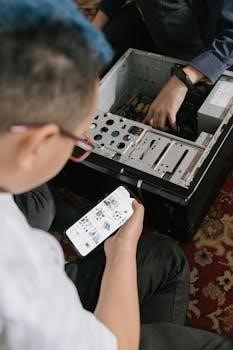
This guide offers insights into diagnosing and resolving common issues with Mercury outboard motors. Addressing problems like overheating, starting difficulties, and performance decline is crucial. Regular maintenance and prompt troubleshooting can ensure optimal performance and longevity for your Mercury outboard engine;
Common Starting Problems
Encountering starting problems with your Mercury outboard can be frustrating, but understanding the common causes can help you troubleshoot effectively. One frequent issue is a faulty fuel pump, which prevents fuel from reaching the engine. A cracked, clogged, or worn fuel pump often results in the engine cranking without starting. Consulting your engine’s repair manual will aid in locating and inspecting the fuel pump.
Another common culprit is a weak or dead battery. Ensure the battery is fully charged and the connections are clean and secure. A corroded or loose connection can impede the flow of electricity, preventing the engine from turning over. Check the battery voltage with a multimeter to confirm its condition.
Furthermore, issues with the starting system itself, such as a faulty starter motor or solenoid, can hinder the engine’s ability to start. Listen for a clicking sound when attempting to start the engine, which may indicate a problem with the solenoid. Inspect the starter motor for any signs of damage or wear. Addressing these potential causes will help you diagnose and resolve common starting problems with your Mercury outboard.
Engine Overheating⁚ Causes and Solutions
Overheating is a common issue in Mercury outboards, potentially leading to engine damage. Several factors can cause this, including a blocked water intake screen. This prevents sufficient water from cooling the engine. Regularly inspect and clean the intake screen to ensure proper water flow. A faulty thermostat can also cause overheating. If it fails to open, coolant circulation is restricted, causing the engine to overheat. Replacing the thermostat is the solution.
Low coolant levels are another common cause. Check the coolant reservoir regularly and replenish as needed, using the correct type of coolant specified by Mercury. A blown head gasket can lead to overheating by allowing combustion gases into the cooling system. Inspect the head gasket for leaks and replace it if necessary.
Furthermore, a damaged impeller in the water pump can reduce its efficiency, leading to overheating. If the impeller blades are worn or broken, the pump will not circulate enough water to cool the engine effectively. Replacing the impeller should solve the issue. Addressing these potential causes will help you diagnose and resolve engine overheating issues with your Mercury outboard.
Poor Performance and Sputtering
Poor performance and sputtering in a Mercury outboard can stem from several underlying issues. One frequent cause is a malfunctioning fuel system. A clogged fuel filter restricts fuel flow, leading to inconsistent combustion and sputtering. Regularly replace the fuel filter to ensure a steady fuel supply.

Another potential culprit is dirty or degraded fuel. Old fuel can gum up the carburetor or fuel injectors, causing poor engine performance. Always use fresh fuel and consider adding a fuel stabilizer, especially when storing the outboard for extended periods. Issues within the ignition system can also result in sputtering.
A weak spark plug can cause incomplete combustion, leading to poor performance. Inspect the spark plugs for wear or fouling and replace them as needed. A faulty ignition coil can also contribute to weak spark, causing the engine to sputter and lose power. A bad trigger can cause various problems, such as misfires, poor acceleration, weak spark, and even a complete lack of ignition. The engine might be difficult to start, stall frequently, or exhibit rough running and reduced performance.
Fuel System Issues⁚ Diagnosis and Repair
Fuel system problems are a common cause of outboard engine malfunctions. Start by inspecting the fuel lines for cracks, kinks, or leaks, as these can introduce air into the system and disrupt fuel flow. A cracked, clogged, or worn fuel pump is often the reason a Mercury outboard cranks but won’t start. Next, check the fuel filter for clogs or debris, replacing it if necessary to ensure a clean fuel supply.

The carburetor or fuel injectors are also prime suspects when diagnosing fuel system issues. Carburetors can become clogged with varnish or sediment, restricting fuel flow. Clean the carburetor thoroughly, paying close attention to the jets and passages. Fuel injectors can also become clogged, leading to poor fuel atomization. Consider consulting a professional for fuel injector cleaning or replacement.
Moreover, ensure the fuel tank vent is open to prevent vacuum lock, which can hinder fuel delivery. Always use fresh, high-quality fuel and consider adding a fuel stabilizer, especially when storing the outboard for extended periods. Look for any possibility of air leaks that are allowing air into the fuel lines. Your symptoms give me the impression that somehow you are losing fuel.
Maintenance Tips to Prevent Problems
Regular maintenance is paramount for preventing problems with your Mercury outboard motor. Start by adhering to the manufacturer’s recommended service schedule, including oil changes, filter replacements, and spark plug inspections. Always use the recommended oil type and capacity for your specific engine model.
Pay close attention to the cooling system, flushing it regularly to remove salt and debris. Inspect the water pump impeller for wear or damage, replacing it as needed to ensure adequate cooling. Check and maintain the fuel system by using fresh fuel, adding a fuel stabilizer, and inspecting fuel lines for cracks or leaks.
Additionally, inspect and lubricate all moving parts, including the throttle and shift cables. Regularly check the propeller for damage and ensure it is properly secured. Store the outboard in a dry, covered location when not in use, and consider fogging the engine cylinders to protect against corrosion during storage.
Finally, change your outboard fuel filter regularly. Catch as much fuel as possible to avoid spills. Proper maintenance not only prevents problems but also extends the life of your Mercury outboard.
Addressing Rough Running and Stalling
Rough running and stalling in a Mercury outboard can stem from various issues, often related to fuel or ignition. Begin by inspecting the fuel system for clogs or restrictions. Check the fuel filter, fuel lines, and fuel pump for any blockages or damage. Ensure that the fuel is fresh and free from water contamination. Consider adding a fuel stabilizer to prevent fuel degradation.
Next, examine the ignition system components. Inspect the spark plugs for wear, fouling, or damage, and replace them if necessary. Check the spark plug wires for proper connection and insulation. A bad trigger on a Mercury outboard can cause misfires, poor acceleration, and weak spark. Verify the condition of the ignition coil and the stator.
Also, look for potential air leaks in the fuel lines. These leaks can disrupt the fuel-air mixture, leading to rough running and stalling. If the engine sputters or stalls at idle, it may indicate a problem with the idle circuit in the carburetor. Clean or adjust the carburetor as needed.
Troubleshooting Weak Spark or No Ignition
A weak spark or no ignition can prevent a Mercury outboard from starting or cause it to run poorly. The first step is to check the spark plugs. Remove a spark plug, connect it to the spark plug wire, and ground the plug against the engine block. Have someone crank the engine and observe the spark. A strong, blue spark indicates a healthy ignition system, while a weak, yellow spark or no spark suggests a problem.
If there’s no spark, check the ignition coil. Use a multimeter to test the coil’s primary and secondary windings for proper resistance. A faulty coil can prevent the spark plugs from firing. Inspect the stator, which generates the electricity for the ignition system. A bad stator can result in a weak or nonexistent spark.

Also, examine the trigger, which signals the ignition coil to fire. A faulty trigger can disrupt the timing and strength of the spark. A bad trigger on a Mercury outboard can cause misfires, poor acceleration, and weak spark. Finally, check the kill switch and wiring for any shorts or disconnections. A disconnected or faulty kill switch can prevent the engine from starting.
Identifying and Fixing Air Leaks in Fuel Lines
Air leaks in fuel lines can significantly impact a Mercury outboard’s performance, leading to rough running, stalling, and difficulty starting. Identifying and fixing these leaks is crucial for maintaining optimal engine operation. Start by visually inspecting all fuel lines and connections for cracks, wear, or loose fittings. Pay close attention to areas near the fuel tank, fuel filter, fuel pump, and carburetor or fuel injectors.
To pinpoint elusive leaks, use a soapy water solution. Spray the solution onto fuel line connections and watch for bubbles, indicating an air leak. Tighten any loose clamps or fittings. Replace cracked or damaged fuel lines immediately to prevent further issues. Ensure that all fuel line connections are secure and properly sealed.
Check the fuel filter for proper sealing and replace it if necessary. Examine the fuel pump diaphragm for any signs of damage or wear. A cracked or worn fuel pump can introduce air into the fuel system. Ensure that the fuel tank vent is open and unobstructed. A blocked vent can create a vacuum in the tank, leading to fuel starvation and air leaks.
Dealing with Carburetor Jet Problems in Four-Stroke Engines
Carburetor jets play a vital role in regulating fuel flow in four-stroke Mercury outboard engines. Over time, these jets can become clogged with debris or varnish, leading to poor engine performance, rough idling, and difficulty starting. Addressing carburetor jet problems is essential for maintaining optimal engine operation. Begin by removing the carburetor and disassembling it carefully. Take note of the jet locations for reassembly.
Use a carburetor cleaner and small wires or jet cleaning tools to clear any blockages in the jets. Ensure that all passages are clear and free from obstructions. Pay particular attention to the idle jet, main jet, and high-speed jet, as these are most prone to clogging. After cleaning, reassemble the carburetor carefully, ensuring that all components are properly seated.
Before reinstalling the carburetor, inspect the fuel lines and fuel filter for any signs of contamination. Replace the fuel filter if necessary. Adjust the carburetor according to the manufacturer’s specifications to ensure proper fuel-air mixture. If problems persist, consider having the carburetor professionally cleaned and rebuilt to restore optimal performance.

Importance of Regular Outboard Motor Maintenance
Regular maintenance is paramount to ensuring the longevity, reliability, and optimal performance of your Mercury outboard motor. Neglecting routine upkeep can lead to a myriad of issues, from minor inconveniences to major engine failures. A proactive approach to maintenance not only prevents problems but also saves you money in the long run by avoiding costly repairs.
One of the most crucial aspects of outboard motor maintenance is regular oil changes. Clean oil lubricates engine components, reduces friction, and dissipates heat. Check the oil level regularly and change it according to the manufacturer’s recommendations. Similarly, inspect and replace the fuel filter to prevent contaminants from reaching the engine.
Additionally, inspect the cooling system for any signs of corrosion or blockage. Flush the system regularly to remove debris and ensure proper cooling. Check the spark plugs and replace them as needed to maintain optimal ignition. Finally, lubricate all moving parts, such as the throttle and shift linkages, to ensure smooth operation. Consistent attention to these details will significantly extend the life of your outboard motor.